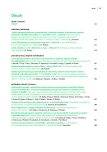Therapeutic monitoring of vancomycin in routine clinical practice
Authors:
Ivana Kacířová 1,2; Milan Grundmann 1
Authors‘ workplace:
Ústav klinické farmakologie LF OU Ostrava, přednosta doc. MUDr. Milan Grundmann, CSc.
1; Oddělení klinické farmakologie Ústavu laboratorní diagnostiky FN Ostrava, primářka MUDr. Ivana Kacířová, Ph. D.
2
Published in:
Vnitř Lék 2014; 60(10): 846-851
Category:
Reviews
Overview
Therapeutic drug monitoring (TDM) is specific method of clinical pharmacology for monitoring of the therapy using measurement of drug serum concentrations followed interpretation and good cooperation with clinician. TDM help clinicians to quickly optimize vancomycin dosing regimens to maximize the clinical effect and minimize the toxicity of the drugs. Minimum serum vancomycin trough concentrations should always be maintained above 10 mg/L to avoid development of resistance, neverthelles trough concentrations > 20 mg/L are not recommended because of the risk of nephrotoxicity. For serious infections vancomycin trough concentrations of 15–20 mg/L are recommended and for a pathogen with an MIC of 1 mg/L, the minimum trough concentration would have to be at least 15 mg/L to generate the target AUC24/MIC ≥ 400 (area under the curve/minimal inhibitory concentration). In non-complicated infections trough concentrations of 10–15 mg/L should be sufficient. For continuous infusions of vancomycin target steady-state concentration values of 15–25 mg/L have been advocated for critically ill patients.
Key words:
therapeutic monitoring – trough concentration – vancomycin
Sources
1. Grundmann M, Kacířová. Význam TDM, fenotypizace a genotypizace pro správné dávkování léčiv. Čas Lék Čes 2010; 149(10): 482–487.
2. Thomson AH, Staatz CE, Tobin CM et al. Development and evaluation of vancomycin dosage guidelines designed to achieve new target concentrations. J Antimicrob Chemother 2009; 63(5): 1050–1057.
3. Ye ZK, Tang HL, Zhai SD. Benefits of therapeutic drug monitoring of vancomycin: a systematic review and meta-analysis. PLoS One 2013; 8(10): e77169. Dostupné z DOI: <http://doi: 10.1371/journal.pone.0077169>.
4. Helgason KO, Thomson AH, Ferguson C A review of vancomycin therapeutic drug monitoring recommendations in Scotland. J Antimicrob Chemother 2008; 61(6): 1398–1399.
5. Moise-Broder PA, Forrest A, Birmingham MC et al. Pharmacodynamics of vancomycin and other antimicrobials in patients with Staphylococcus aureus lower respiratory tract infections. Clin Pharmacokinet 2004; 43(13): 925–942.
6. Rybak MJ, Lomaestro BM, Rotschafer JC et al. Vancomycin therapeutic guidelines: a summary of consensus recommendations from the infectious diseases Society of America, the American Society of Health-System Pharmacists, and the Society of Infectious Diseases Pharmacists. Clin Infect Dis 2009; 49(3): 325–327.
7. Matsumoto K, Takesue Y, Ohmagari N et al. Practice guidelines for therapeutic drug monitoring of vancomycin: a consensus review of the Japanese Society of Chemotherapy and the Japanese Society of Therapeutic Drug Monitoring. J Infect Chemother 2013; 19(3): 365–380.
8. McKenzie C. Antibiotic dosing in critical illness. J Antimicrob Chemother 2011; 66(Suppl 2): ii25-ii31.
9. Patel N, Pai MP, Rodvold KA et al. Vancomycin: we can’t get there from here. Clin Infect Dis 2011; 52 : 969–974.
10. Albur MS, Bowker K, Weir I et al. Factors influencing the clinical outcome of methicillin-resistant Staphylococcus aureus bacteraemia. Eur J Clin Microbiol Infect Dis 2012; 31(3): 295–301.
11. Martin JH, Norris R, Barras M et al. Therapeutic monitoring of vancomycin in adult patients: a consensus review of the American Society of Health-System Pharmacists, the Infectious Diseases Society of America, and the Society of Infectious Diseases Pharmacists. Clin Biochem Rev 2010; 31(1): 21–24.
12. Liu C, Bayer A, Cosgrove SE et al. Clinical practice guidelines by the Infectious Diseases Society of America for the treatment of methicillin-resistant Staphylococcus aureus infections in adults and children: Executive summary. Clin Infect Dis 2011; 52(3): 285–292.
13. Begg EJ, Barclay ML, Kirkpatrick CM. The therapeutic monitoring of antimicrobial agents. Br J Clin Pharmacol 2001; 52(Suppl 1): 35S-43S.
14. Li J, Udy AA, Kirkpatrick CM et al. Improving vancomycin prescription in critical illness through a drug use evaluation process: a weight-based dosing intervention study. Int J Antimicrob Agents 2012; 39(1): 69–72.
15. Petejová N, Martínek A, Zahálková J et al. Vancomycin pharmacokinetics during high-volume continuous venovenous hemofiltration in critically ill septic patients. Biomed Pap Med Fac Univ Palacky Olomouc Czech Repub 2014; 158(1): 65–72.
16. Petejová N, Martínek A, Zahálková J et al. Vancomycin removal during low-flux and high-flux extended daily hemodialysis in critically ill septic patients. Biomed Pap Med Fac Univ Palacky Olomouc Czech Repub 2012; 156(4): 342–347.
17. Petejová N, Martínek A, Zahálková J et al. Vliv kontinuální a intermitentní náhrady renálních funkcí na antibiotickou léčbu u kriticky nemocných v sepsi – praktický pohled na léčbu vankomycinem a gentamicinem. Vnitř Lék 2012; 58(6): 448–454.
18. Horey A, Mergenhagen KA, Mattappallil A. The Relationship of nephrotoxicity to vancomycin trough serum concentrations in a veteran's population: a retrospective analysis. Ann Pharmacother 2012; 46(11): 1477–1483.
19. Státní ústav pro kontrolu léčiv (SÚKL). Dostupné z WWW: <http://www.sukl.cz>.
20. Nunn MO, Corallo CE, Aubron C et al. Vancomycin dosing: assessment of time to therapeutic concentration and predictive accuracy of pharmacokinetic modeling software. Ann Pharmacother 2011; 45(6): 757–763.
Labels
Diabetology Endocrinology Internal medicineArticle was published in
Internal Medicine

2014 Issue 10
Most read in this issue
- Therapeutic monitoring of vancomycin in routine clinical practice
- Optimal way of administration of high dose intravenous furosemide – continuous infusion or bolus?
- Monoclonal gammopathy of undetermined significance and asymptomatic multiple myelom in the year 2014
- Gout and cardiovascular risk
